Homes built in the last 40 years in Canada are relatively airtight. Before that we generally relied on leaky uninsulated walls to provide fresh air and prevent mold and mildew, and they did that very well.
Cost and comfort had us adding insulation, but not necessarily sealing our walls. The folly of this was quickly realized, and vapour barriers became a part of the building envelope shortly thereafter.
Vapour barriers stopped the flow of moist air through walls, this of course led to a buildup of moisture in homes, and condensation on windows was common place and hard to stop. This led to a build up of mould and mildew in homes. Modern day airtight homes need mechanical assistance to stop moisture damage and protect indoor air quality, especially true in basements where ventilation is essential to stop mold forming.
There are still those that profess that walls need to breath and that 'houses are too airtight', but this myth is completely false and very damaging to your home. Walls need to be able to dry, ideally in both directions.
Natural air flow:
If you hold a door open a crack in winter, natural convection will draw air in at the bottom, and force it out at the top. Your home will behave in a similar way, this is called the stack effect.
Warm air rises, forcing air out the top portion of your home and drawing in cold air from the bottom to replace it. How much air will be changed depends on how well-sealed your home is.
While natural convection will offer a certain amount of new air, with most new homes it just isn't sufficient. Properly sealed homes require mechanical ventilation systems to remove moisture and provide sufficient fresh air for occupants.
Ventilation systems- What is an HRV?
Mechanical ventilation systems are known as heat exchangers, HVACs (Heating, Ventilation and Air Conditioning) or HRVs (Heat Recovery Ventilators). The point of these systems is to remove moisture and provide fresh air to your home that is pre-heated by the outgoing air.
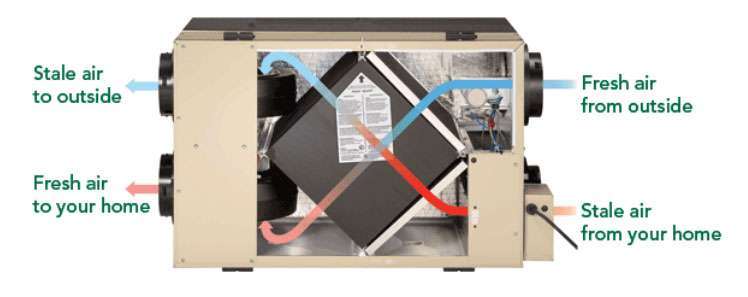
The core of an HRV has small separated channels that air passes through, allowing incoming air to be preheated by exhaust air. There are no heating coils, you are simply operating fans, so they are relatively cheap to run. And you will certainly save money overall, as heating moist air eats up a lot of energy.
Depending on the quality of the machine you buy, you can expect to recoup anywhere from 50% of the heat in the air, to as much as 95%. Plan on spending around $2,000 installed, that's for a reasonably efficient one. Double that for the high end models with aluminium cores that conduct heat better than plastic ones do.
Ventilation Systems- What is an ERV?
Energy Recovery Ventilation (ERV) is the process of exchanging the energy contained in normally fan extracted stale or humid air from homes and using it to treat (precondition) the incoming outdoor fresh air in residential and commercial HVAC systems. During warmer days, an ERV system pre-cools and dehumidifies while in the winter season ERV systems humidify and pre-heat incoming air from outside the house. One benefit of using energy recovery in the USA is the ability to meet the ASHRAE ventilation and energy standards, while improving indoor air quality and reducing total HVAC ratings and energy requirements.
ERV technology is not only an effective means of reducing energy cost and heating and cooling loads, but allows for smaller equipment. Additionally, ERV systems allow for maintaining the ideal relative humidity of 40% to 50% in indoor home environments. This range can be maintained under more or less all conditions with the only energy penalty being the electric for the blower to overcome the pressure drop in the system.
If you need help choosing between an HRV & ERV system, see here
Indoor air quality is important for many reasons:
-
Preventing moisture issues such as rot and mold
-
Preventing damage to windows from condensation
-
Preventing respiratory illnesses caused by interior contaminants
-
Reducing heating costs by not heating excess water vapour which will leak from your home.
Ideal humidity levels:
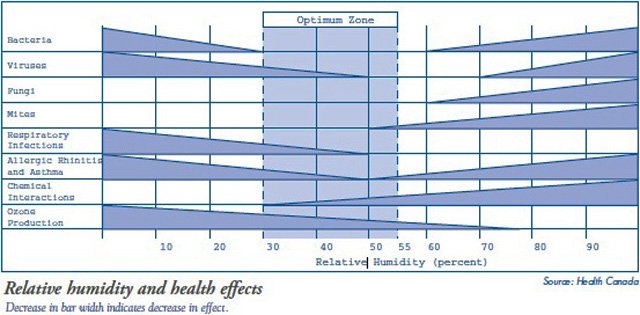
|
|
© Health Canada
|
Along with removing contaminants from the air, there are health consequences from having either too much or too little moisture in our homes. There are bacteria, viruses, moulds and mites that will show up on either end of the spectrum if your air is either too humid or too dry.
Somewhere in the range of 35 to 50% relative humidity is generally assumed to be the best for avoiding most health risks and irritants. It’s high enough that you won’t have cracked furniture, chapped lips or constant nose bleeds, and it’s not too damp for comfort, condensation or heat consumption.
If you are in an older home, don’t panic. What we write in these pages is meant to inspire ideas and solutions, not fear and anxiety. If you feel good, your air smells good and your windows aren’t dripping, relax.
For peace of mind, consider buying a hydrometer to measure your indoor relative humidity, which will cost you maybe $20 to $30 at most hardware stores. If you have an issue, crack your window a bit for now until you sort it out. Humidifiers, dehumidifiers and air purifiers are available to deal with some of these issues.
A dehumidifier will cost between $200 and $300 to purchase, and maybe $10 to $15 a month to operate. This added cost will likely be negated by heat savings, as heating moist air requires a lot more energy than heating dry air.
If you plan to undertake an HRV or ERV installation project yourself, do your research first to determine proper vent placement. An intake in the bathroom rather than a simple exhaust fan for example, will mean heated incoming air instead of just creating negative pressure and letting cold air find its own way in everytime someone turns on the fan.
You won't need to install a bathroom fan of course if you have an intake in there, just be sure to put a timer switch so you and your guests can turn it on. Having an intake in or near the kitchen helps pick up general moisture and contaminants, but don’t hook it up to your stove hood. It's not a good idea to send cooking grease through an expensive heat exchanger.
And as for installing duct work, the flexible tubes are cheaper and easier to work with, but can be quite noisy and the ribs slow air movement forcing your air exchanger to work harder.
Since your fresh air vents are best located in living areas and bedrooms, you might find that it’s well worth the added cost of solid ducts simply for noise reduction.
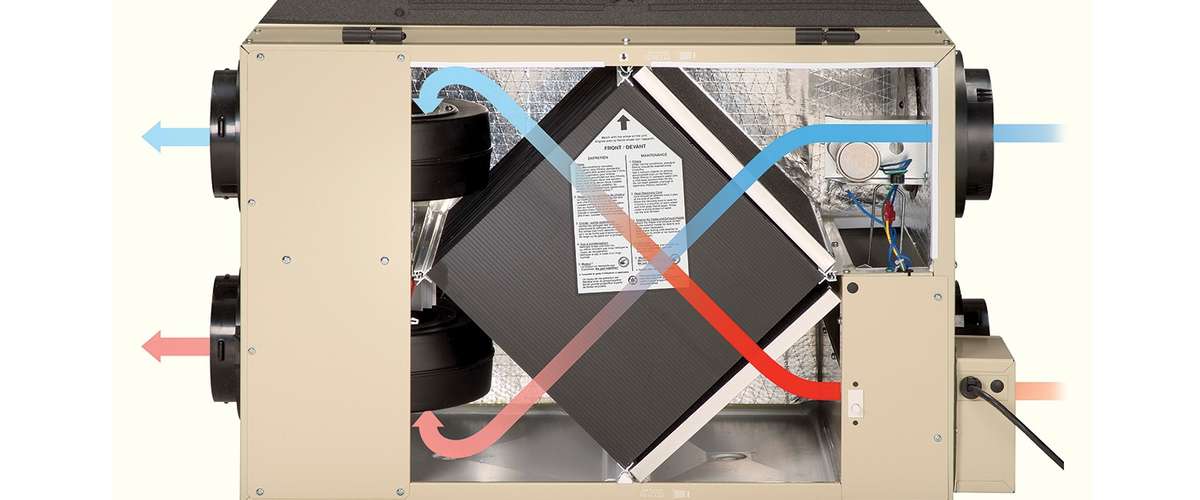



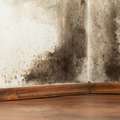

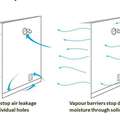










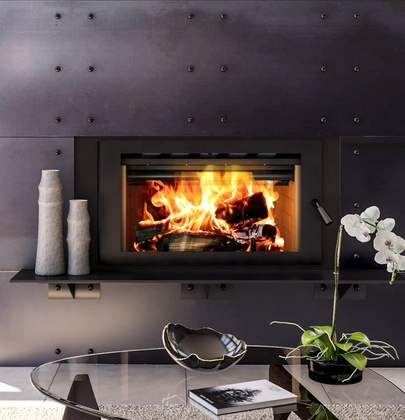

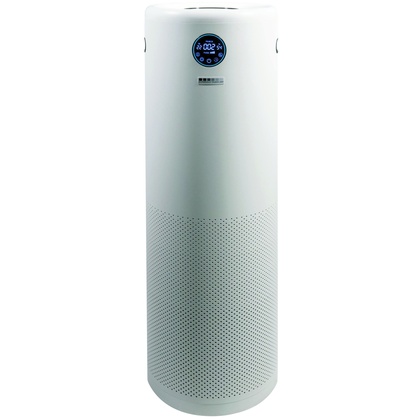

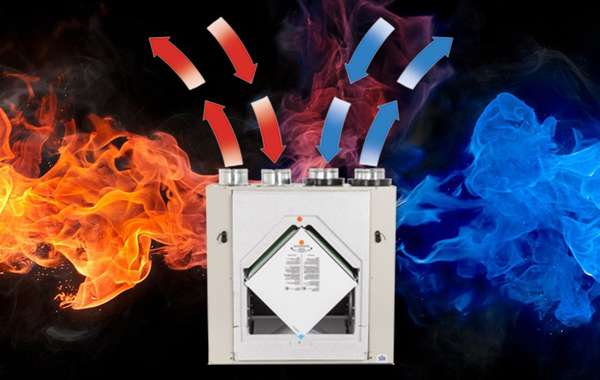
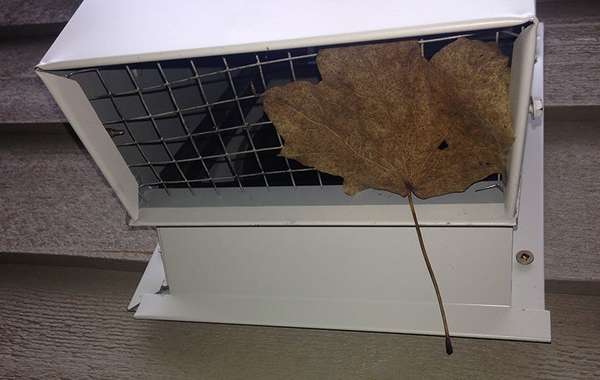
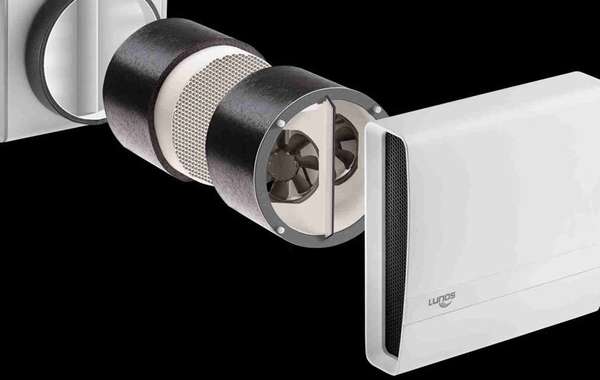
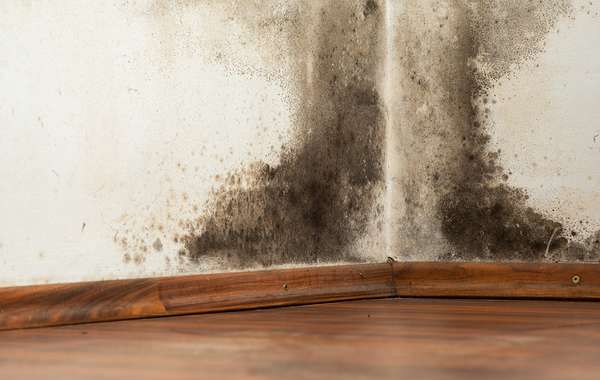
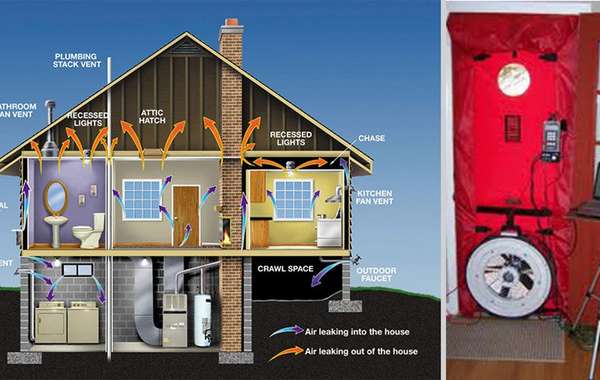
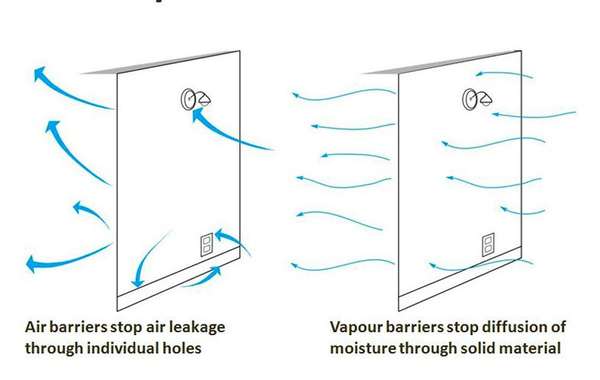
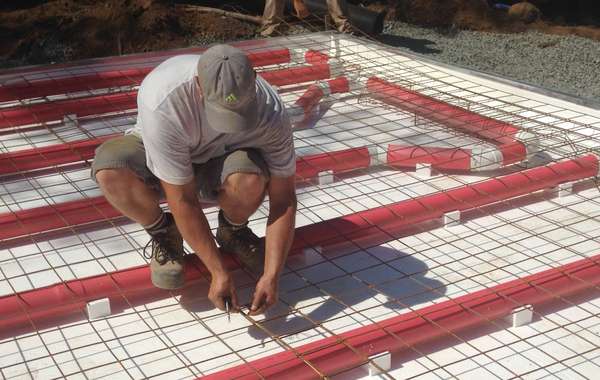
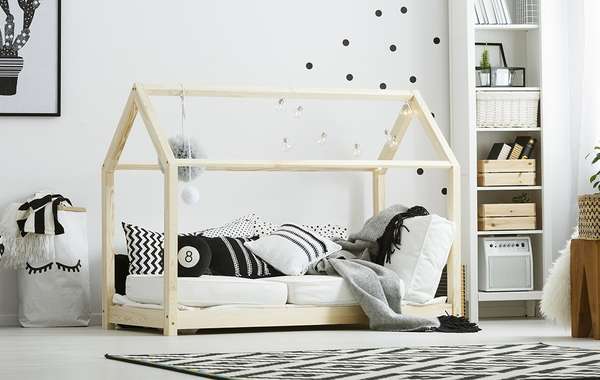
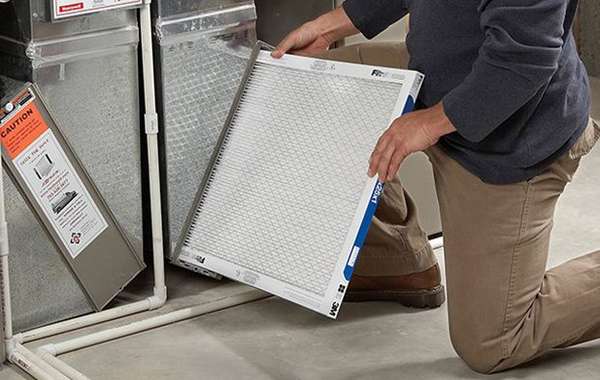
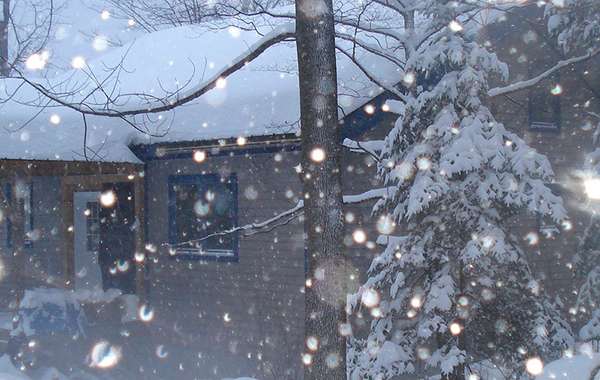
We cannot eliminate the moisture on our bathroom windows during showers. we've tried all sorts of combinations of having the windows open and closed, exhaust fan on or off, air exchanger on and off, cleaned air exchanger. Nothing seems to work. Help!!!
Don't worry unless the moisture stays for more than 20 minutes after your shower. In a small bathroom you would have to have a very high output fan to avoid any condensation on the windows. As long as it clears quite quickly after the shower it will not cause any trouble.
Good point. If your overall humidity levels in the home aren't bad it probably isn't a huge cause for concern, you might consider measuring your home humidity levels, and specifically the bathroom. That might help you find out how long the moisture is sticking around, and how long after a shower you should run your fan.
I have a new home and my windows had condensation on them but my humidity level was at 23%.... My contractor said turn the air exchanger on and bring up the humidity... does that make any sence?? ps. the humidity level is now 30% and there is no condensation...
If you had condensation at 23%RH and not at 30%RH, I'm guessing that you had the condensation during the deep freeze over the last two weeks in eastern Canada and the U.S.? Two factors are at play causing condensation on your windows- the amount of moisture in the air inside your home, and the temperature of the glass, which is affected by the temperatures outdoors. 23% RH is quite low, so I'd say temperature, and when you had no condensation at 30%RH it had probably warmed up some? Even the best windows will show condensation at some point, so unless it is frequent and extreme its not that unusual. Also, having a new home does not always mean you will have great windows, and unless you specifically asked your contractor for triple pane gas filled high performance windows, you likely don't have them. Regardless, 23% RH is quite low, any lower and you will have chapped lips and nose bleeds. Where I am we dropped to around -30 C, and with triple pane argon filled windows and I had moisture. Happy to help you trouble shoot it more if you like, that would take location, temperatures, window stats and exactly home much moisture you had. Regards, Mike
Hi, My home is 10 years old, we always have moisture on our window's, this year I put plastic on all windows with the exception of the kitchen and the patio door. We are considering replacing all of our windows as the builder installed really cheap windows. I borrowed a hydrometer and the humidity level in my house is 71% on our main floor (we have an open concept back-split)our deep basement is at 62%. I do open the door to let the air change but I have not noticed a change in humidity. In your opinion would a venmar or air exchanger work for us?
Can you recommend a good brand and a company who can install an air exchange system in my house:2 floors and a basement in Montreal.
Our Quebec based French website has a green building directory that should help you find someone.
Have you checked to see if your bathroom fan is really hooked up? I went into my attic last year to find the builder had simply left it exhausting into the attic insulation. Thus, it wasn't very efficient.
Also make sure that any exterior flaps are actually opening. They can freeze or seize shut.
With the changing era,the myths for keeping home well ventilated also changed. Prior people prefer to have airtight houses but with time they understands the importance of ventilation for keeping their family healthy.
I have an air exchanger. Mice have nested in the insulation of the 'ducts' . If I get rid of mice, should I replace the ducts. If so, how do i purchase just the duct work?
Interested in learning about heat recovery ventilation (HRV) and energy recovery ventilation (ERV) systems, check out the following link: http://aecdai.ly/8v
Hi, in our house there is one opening in the basement,the other is at the highest point at the stairs onthe ceiling.For the air exchanger,which opening is the inlet,and which one is the outlet in this case? Thanks
Hi, I recently moves into a home with an air exchanger. Im unfirmiliar with how they work. What is a good setting to have it on? im guessing the numbers are for humidity levels? the dial on the wall has these options ------> off 80 70 60 50 40 30 20 on
I have this idea for using ambient soil as a source for warming and cooling fresh air intake. It seems too simple and good to be true, so it probably is. Looking for feedback.
I am planning on building a small house with a basement. Before backfilling, I was planning on burying X # of lengths of solid 4" or 6" drain pipe (PVC? ABS?)around the foundation with an air intake above ground on the outside and a place (in the basement or on the main floor (?) for the 'conditioned' air to enter the house. Bathroom fans, etc. would ostensibly manage the outflow of stale house air.
I am imagining minus 10C air coming into the house much warmer from it journey around the foundation, while in hot summer months, the air would be cooled.
Thoughts?
I would also put an intake behind the refrigerator, thus recycling the heat produced by the fridge. I have also got intakes near the ceiling in my skylights.. We pay to heat our homes, we may as well keep the hot air circulating and mixing with the new fresh air.
MI put 6 mm poly on my windows as it is a total heat escape addition of glass.
My concern is the plastic is sticking to the windows with moisture build up.
Will they crack in sub zero (-40 C) temperatures ???
I put 6mm poly on a large windowed addition.
I am concerned that the condensation (exterior) will crack the large panes of glass.
Every home is different , depending on how many people and style of life , how tight the house is etc... I use to tell people if you see moisture on the windows turn it up enough to cut it in etc.. There is no need to have it on bust if there is no moisture in the house. I know people have problem of having it on auto and making the house to dry so night time they had in plug into a timer to shut it down for 6- 8 hours when they went to bed, but never off.
I live in Newfoundland , Canada. We get mixed season. So I use to tell people use the HRV in the Spring and Fall, The really cold Winter months use a dehumidifier, and in the summer open the windows....
Tried to find info in Building Code. Can't seem to find anything like ours.
We are a condo corp, two stories. All upper units have same problem. All vents are installed (facing down) on roof overhang. There are no flap covers on any of the vents. Condos are cold. Only heated with fireplace in living rooms, baseboard heaters in bedrooms. Middle of condo (kitchen area, dining room) always cold. Back of condos face west. All vents are in back. Wind hits back wall(s) of condos and come in all the vents. We could use our microwave as a mini-fridge too. If you stand/sit under ANY of the vents, there is cold air coming in. Condos are 4 years old. Lower units have no problems. Can anyone guide us (I'm on Board of Directors) as to whether this is 'normal' or how to rectify. Thank you in advance for any help you can offer! Fran Perks, Rockland, Ontario.
What would cause an air exchanger to have a small leak
why would I get frost build up on my fresh air intake on my air exchanger?
we have air exchanger..installed in basement.. the intake of stale air is in hallway upstairs and the out of fresh clean air is in basement.. we would like to put the out fresh air upstairs. where would the best place be to put it..? thankyou
The fresh air in (in these parts) is quite cool! If you want it to go up pipe it into your return air and through the furnace, at least it has time to warm up. I had a duct into the kitchen wall, and felt it.
I spent a year researching HRV/ERV and what I found was HRV is the better choice overall. The make I finally decided was the best is vanEE - I had a heck of a time sourcing a "local" installer that carried the line (could not source a direct purchase capability). Then presto, source was found - long story short, I had the vanEE 100H installed - thoroughly impressed with it's operating and performance. As I am in NB, no sense in giving you the name of the installer I had. Cheers
Hi. I live in south central Saskatchewan and my house was built in a1980. It is well insulated but I get sweat on the windows all the time. I got a mid efficient furnace that's 7 years old. Looking at an air to air exchanger its made by Venmar its a Constructro 1.5. Now my house is an 1100sq/ft bungelo. I was wondering if I could just tap into the existing heat ducts and cold air return or do I run separate lines and if that's the case do vents have to be high and low or can they all be put at floor level? And how many do I need? Do I really need 1 per room. Thanks
Picking the best system would be best done with the help of an HVAC specialist I think. Air exchangers are a great idea, but with existing homes its best to go on a case by case basis. If you have that much moisture I would think about a dehumidifier maybe, and with any double pane window you are bound to get humidity on the really days anyway. Another option to consider might be a Lunos ductless mini split HRV ERV system, they install right into walls, have a look. All the best.
Great advice, thank you.
Should the Heat Exchange run when we are leaving the windows open?
Hi Michael, you might as well shut if off if you have crossflow of air anyway. The HRV and windows would be doing the same thing.
What do you think would be the cheapest option to lower humidity and bring in fresh air with existing attic ductwork and doing the work myself. I have forced air and an air scrubber installed currently. The house is cinder block so the one in this video seems like it would be pretty difficult to do.
brush on xypex to seal cinder block. A dehumidifier upstairs, beap floor fan downstairs. A touch of one window opening in the basement and one on top floor. My old home is very dried and warm like this. I had owned two other homes before So I can tell the difference.
no
I have a brand new home, moved into in June. Have furned on Venmar now. It sounds like my furnace is on all the time. I use a wall control. Is this normal? Im trying to make sure we are doing it right.
Yes, an air exchanger should be running for many hours a day, don't be surprised by that.
We always open a basement window whenever we run a bathroom fan, kitchen range hood, or the dryer. Can we stop doing this once we install an HRV? Would running the fan during a shower, for example, draw air into the house through the HRV?
Opening a window to allow a bit of makeup air when running exhaust fans is a good idea, An HRV won't really change that. If your HRV exhaust pulls air from the bathroom that's one thing, but if it is a fan vented directly outside then opening a window is still a good idea. As for making that a basement window, you may be just as well to have that an upstairs window, depending on the air quality in the basement, meaning if it is musty (as many are) or if it has elevated levels of radon gas, in which case, an ground floor window may be preferrable to open I think.
Our home is 14 yrs old. We had an air exchanger installed, we never use it. We had the installer come back and check what was going on, we were getting mold in the basement. He said he had the duck work backwards and fixed it. Well we still got mold and cannot use it. Can you give me an idea what I can do, cause we always have mold, our basement is completely finished, and we have a brand new exchanger hanging on the ceiling not working for 14yrs.
Basements are typically built in a manner that encourages mold growth, I would first look at this page here about Why basements are moldy and how to build them properly. I hope that helps.
I have a quality-built 3 year old home with an ERV. Humidity is always in the 40% area. I have begun to smell musty air in my home. The smell is noticeable year round. In the summer months, I run a demudifier constantly. My furnace has been checked out with no mould issues. the technician suggested that I run my AC constantly which I've been doing. It helps but I can still smell the oder. I change the furnace filters every 3 months. The ERV is in SMART mode 24/7 exchanging air from the outside. Why am I smelling this horrible oder?
Hi Evelyn
It's tough to trouble shoot from a distance, but I can offer a couple of suggested sources you may want to check. I would look at the HRV core to make sure it isn't moldy, not that it would be but at least you can write that off as the source.
Are you particularly sensitive? I'm wondering if it is so prevalent that others smell it as well. the other thing I wonder about is, how the basement is constructed. The standard method of building basements is a perfect recipe for mold, where a stud wall and fiberglass insulation are pressed against a wet concrete wall then covered with a sheet of plastic. Most basements in colder climates are built like that so it is only a matter of time until mold develops, though three years is a bit quick to be smelling it, that's why I asked if you happen to be particularly sensitive to mold.
I have been running air exchanger (new install 2019) with no heat or cooling for the last 2 weeks. I have been waking up with blocked ears, it Almost feels like a negative pressure in the house...is it possible this could be caused by the air exchanger or is it just a coincidence? Thanks!
Yesterday I had both the furnace and air conditioner checked out. They are clean. The HVAC tech suggested he install an untra-voilet light on the furnace to kill any spores coming in through the furnace. I may be sensitive to mold, but others can smell it as well. My basement is unfinished but constructed as you have described. I'm wondering about the north side of the house which doesn't get any sun as there is only 4 feet between the house and my fence. The area has started to grow moss killing the grass. There is a green color on the outside cement wall along the grass line. Since the ERV vents are on that side of the house, could it be pulling in bad air from that area? Perhaps during heavy rainfall, the area is getting drenched and not draining well away from the house. There is never any water pooling after rainfall in the area. I have plans to remove this section of dirt, grass and moss and re-grade it to slope more towards the fence. Then I want to lay down some nice beach stones or gravel to ensure the area is dry. I appreciate your help.
When you say your basement is constructed as I described, and you've checked all other sources, I would think the way the basement walls are built is starting to look like the more likely culprit. If wood studs and fiberglass insulation were sandwiched against a wet concrete wall and covered with a sheet of plastic, that will in all likelyhood be a source of mold in the near future, so if you're sensing mold now, then I'd look into that. I would find a spot on the wall you don't mind cutting open and investigating to see what its like back there, which should also offer you a big waft of the smell you are sensing, if that is in fact the source.
First of all, it really is built poorly so there really isn't much harm you can do other than aesthetically. So cut the drywall, cut the poly vapor barrier and see if it wet behind there and see how it smells. If that turns out to the the source of mold I would look into your building warranty so if the framed walls need to be demolished and rebuit that you don't end up picking up the bill for someone else's mistakes.
I wonder whether the air venting to the outside from the cold storage area is being picked up by the ERV and circulating it throughout my home. It's not a mildew odour but certainly not clean the clean air an ERV is designed to provide.
I have a log house built in 2010. Heated with infloor gylcol gas boiler. In the last couple years started noticing more dust which was there before. The house has since done all settling which has closed near all air gaps from 10 years ago. No problems with condensation on windows and live in northern alberta. Will an air exchanger help with this issue?
Hi Barb, an HRV or ERV would likely help with dust, make sure to install the right filter, see this page here - Choosing the right home air filters. I can't guarantee of course that that will solve all your dust issue, but modern homes are generally built more airtight than in the past and need mechanical ventilation to remove humidity and airborne contaminants.
The basement is unfinished, so I cut open a spot on each of the three outside walls and checked behind the indulation. No smell. The last few days temeperatures have permitted no heating or cooling in our area but the EVR has been constantly on. This morning I could smell moldy/musty odor coming from floor vent.
Hi Evelyn, to your above comment, yes, it is possible that you may be drawing in exhaust air if there is not enough distance between it and the intake. Have you done a smell test outside? If the exhaust air does smell moldy close to the fresh air intake then that could be it.
I'm looking at proposing single-room HRVs for installation in my kids' classrooms. The school is heated by hot water boiler, so there is no ventilation per se aside from windows in each classroom. Can you recommend any good single room HRVs that would work for an approx 900 square foot classroom? Also curious if you can mount them through a window (using plexiglass or another material to hold the ducting) instead of going through the wall.
Hi Ryan, you may have some luck with this, they are wall insert ductless ERVs.
Hi. I have a hrv system in place (about 4 years old. About two years ago I had a wood burning fireplace insert installed in a masonry fireplace. The house seems to fill with smoke at random times once it's been lit for awhile. Someone mentioned that the fire will eventually create negative air pressure in the house, and suck the smoke back in. Are there any systems that monitor air pressure and automatically bring more or less air into the house. Hoping to eliminate the constant Smokey smell. Thank you
Hi Mark, a wood stove will for sure cause negative air pressure, but the result of that in a super airtight house would be that the fire wouldn't burn well rather than filling your house with smoke. If your home randomly fills with smoke I would look for other sources of depressurization, could it be when someone turns on a bathroom ventilation fan or stove hood? When that happens you are for sure at risk of smoke coming back into you home if the door is open.
I would start with a little fan testing forensics and see if that is what is causing it. You may also need HRV maintenance, if the core is plugged up with debris it may throw off the balance by ejecting more air than a plugged filter allows in. Another reasonably common cause of depressurization in homes is debris clogging your HRV intake. Here is our page on how to keep your HRV clean and operating efficiently
Hi Mike, when the HRV doesn't operate, what prevents it from constantly drawing cold air from the "fresh air to home" from outside. I feel and fear there is massive cold air coming in constantly. The central air system has a massive sucking power connected directly to the HRV, nothing prevents it from drawing air directly from outside through this path. Dont tell me about the house HVAC system being balanced, all the bathroom vents, kitchen vents, dryer vent and various leaks can all exhaust positive pressure. The air will always use the path of least resistance, so instead of drawing air from upstairs, it draws it through the HRV and therefore from outside. I continue to beleive that my HRV is "leaking in" massive quantities of cold air when it's not working and would like to be proven otherwise. Thanks!
Hi,
I'm also wanting to find out more about the question posed by Mark above. I'm planning to install a wood burning stove and have heard that a depressurized house, such as when a kitchen extractor fan is running, can certainly cause smoke to leak into the house from the stove. What I'd love to see is an HRV or ERV that can sense depressurization in the house and be able to run in such a way that it brings in more air in from outside than it is expelling in order to counter the cause of the depressurization. Obviously the efficiency of the HRV will drop if there is more air entering than leaving, but still better than nothing.
Anyone know if this is a thing?
Several sources recommended to install HRV near there it terminates externally, which mean outside wall. Some said this is to avoid condensation on ductwork (which can be fixed by insulating the ducts), other said it is to avoid having to box in the larger fresh in and exhaust ducts (can be fixed by box in the duts). Do you have other ideas? Also, is there any recommended 'maximum' duct lengths for 'each' of the 'four' ports of an HRV?
We moved away from our scandanavian style wood framed house for a year. When we came back, the people living here hadn't changed the filters and the recuperator was off. When I opened the main door, the entire inside was covered in a black, fuzzy mold. I also discovered the same black fuzzy mold behind a baseboard that was peeling off the wall in one of our rooms. Is there a process for cleaning out and disenfecting all the ducts running from the recuperator? Also, how worried do I need to be that mold might have gotten inside the walls of my house? Thank you for any help or guidance you can provide!
So, recently purchased a 1994 home that originally had a non HE furnace and water heater sharing a chimney flue (pretty standard). Some time ago a HE furnace was put in. The water heater still uses the same chimney flue. I noticed back drafting of the water heater. We switched the gas logs in the fireplace back to wood. This is when we noticed the back drafting and that the house definitely had negative air pressure. I'm contemplating a direct vent water heater to eliminate the back drafting issue. I still will have the negative pressure issue with the fireplace. This is why I'm looking into a HRV or ERV.
Thoughts?
Hi Chuck
A Heat recovery ventilation system is pretty much always a good idea for a home unless it is very old and extremely leaky and getting enough fresh air from lack of an air barrier. The other good thing about that would be that if you get a quality experienced installer they would be able to adjust the system to ensure air pressure is balanced. Another suggestion I would make is perhaps installing a direct air feed to your woodstove.
Typically wood stoves are installed so they are fed with air from the room, so for as long as it is burning you are depressurizing your house. I have a woodstove in my home and I have a direct feed from outside to the back of the stove, so it uses exterior air and does not suck air from the home. That way it acts only as a radiator and does not either draw air through flaws in the air barrier (even the best houses have some) or air from the basement that, in my case at least, is a little too high in radon gas. There's a couple of ideas, hope it helps.
Hi I recently brought a flat which sound travelling between, I am in the second floor since then I have experience moulding and condasetion what your advice to tackle this issue, your help will be much appreciated thanks.
Hi I have been fighting a battle of window condenastion (icing) on my 2000sf ranch for 9 years now. Location zone 6 built energy star ach @ 50: .80, Marvin integrity windows, ZipR, all cellulose, ceiling r51, walls r21, slab r8, erv, r23 icf foundation with sheetrock over. Just installed a new Carrier Infinity 96% propane with 5 stage heat pump, new duct. Can not get my rh below 60%. I have had several HVAC companies look but not helpful. Basement is a constant 58F in winter and 62F in summer. Do I need a dehumidifier or an HRV? Please help.
Bob
Do you live in a particularly humid climate? I am suprised that HVAC pros looked at it and couldn't determine the source or figure a solution. Without seeing it we are at a disadvantage for trouble shooting, but I think the quickest and cheapest solution would be a dehumidifier. They only cost a couple of hundred dollars and it would deal with the problem quite quickly, not to mention that having another professional come to assess the problem may in fact be more expensive than the dehumidifier itself.
I would also be very careful to reduce moisture as much as possible by such practices as putting lids on cooking pots, using your stove hood and always using a bathroom fan when showering. If you try a dehumifidifer let us know how it goes.
Any suggestions about integrating an HRV with an earth tube? I'd think that in winter, pre-warming the incoming air before it enters the HRV would be beneficial, even with a very efficient HRV like Zehnder. (The HRV would probably need a booster fan on the earth tube to draw in enough air.) How would this work in the summer, when temps. were high enough to need cooling? Could an HRV provide enough cool air (in a well-insulated, thermally-efficient house (even of not to Passivhouse standard) or would this require that the earth tube system be run on its own with separate ducting?
I just installed an ERV and CO2 levels are down :) We have a furnace wth radiators in every room. I would like to put an ARV exhast vent in the utility room with the furnace. There is also a fresh air intake terminated low a few feet from the furnace. My understanding is that it brings fresh air to improve combustion but I also see that it would ensure that carbon monoxide is flowing out the chimney instead of getting backed up in the house. Should I vent the utility room to ERV and can I remove the old frash air intake as long as the house is slightly pressurized by ERV?
ARV=ERV just mispelled